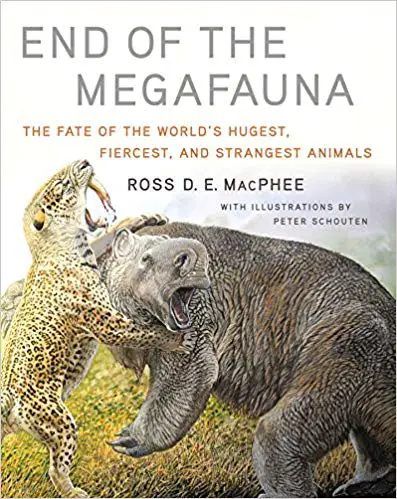Paleomammologist Ross D. E. MacPhee looks at the loss of large animal species towards the end of the “near time” extinctions that have taken place in the last 50,000 years or so, highlighting what makes them unique, and examining the various theories of their causes.
End of the Megafauna: The Fate of the World’s Hugest, Fiercest, and Strangest Animals (W. W. Norton & Company)
In End of the Megafauna, Ross MacPhee looks at the widespread extinction of megafauna, animals weighing over 100 lbs., that occurred toward the end of the Pleistocene epoch, specifically within the last 50,000 years. MacPhee first introduces the concept of megafauna, and the losses that occurred before diving into the competing theories of how.
The two ideas that MacPhee most focuses on are Paul S. Martin’s overhunting hypothesis and the climate change hypothesis. MacPhee carefully looks at each in detail, pointing out where both seem to be successful explanations, and where each theory falls short. In particular, MacPhee brings to light some of the newer discoveries that poke holes in each prevailing theory.

MacPhee also examines other hypotheses for the near-time extinctions. These are briefer, but help the reader better comprehend the depths to which we don’t understand these particular events. MacPhee is careful to make no strong conclusions in the book, except to point out that the various hypotheses may all have some validity or worked in conjunction with one another.
End of the Megafauna also heavily features illustrations by Peter Schouten, which not only do a great job highlighting the diversity of the extinct megafauna, but also juxtapose them with their still extant contemporaries. In doing so, the images provide a visual context for MacPhee’s words, giving a real power to the mystery at the heart of the book — why are some of these animals still around, while so many others are lost?

The illustrations are nicely integrated with the text, helping tell the story rather than interrupting it. The composition of the images is lovely, especially when Schouten is tasked with providing environmental scenes. Numerous species, familiar and alien, appear together in an environment that readers will seem to recall, but is just a little different. It’s a nice window into a past that was lost for still largely unknown reasons.
End of the Megafauna is set to be released on November 13th, 2018.
Join the AIPT Patreon
Want to take our relationship to the next level? Become a patron today to gain access to exclusive perks, such as:
- ❌ Remove all ads on the website
- 💬 Join our Discord community, where we chat about the latest news and releases from everything we cover on AIPT
- 📗 Access to our monthly book club
- 📦 Get a physical trade paperback shipped to you every month
- 💥 And more!















You must be logged in to post a comment.